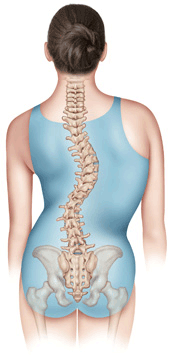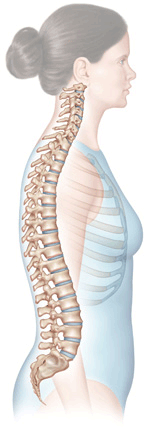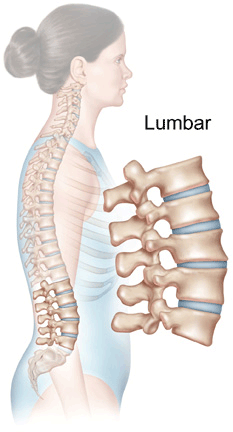Scoliosis

Introduction
It is natural for the spine to curve forward and backward to a certain degree; this is what gives the side-view of the spine its "S"-like shape. But occasionally the spine twists and develops curves in the wrong direction-sideways. When the spine twists and develops an "S"-shaped curve that goes from side to side, the condition is known as scoliosis.
Learn more about scoliosis including
- what parts of the spine are affected
- how various types of scoliosis develop
- how the condition is diagnosed
- what symptoms are present
- what treatment options are available

Anatomy
In order to understand your symptoms and treatment choices, it helps to begin with a basic understanding of spinal anatomy. This includes becoming familiar with the various parts that make up the spine and how they work together. Learn more about the anatomy of the spine.
Learn more about the anatomy of the spine.
A scoliosis curve can occur in the thoracic spine, the lumbar spine, or both areas at the same time. When the vertebrae in the mid and low back curve to the side, the normal appearance and condition of the spine and its muscles changes. The severity of the scoliosis is measured in degrees by comparing the curves to "normal" angles. Curves can range in size from as little as 10 degrees to severe cases of more than 100 degrees. The amount of curve in the spine helps your doctor decide what treatment to suggest. Conservative (nonsurgical) treatment is usually suggested for curves of less than 40 degrees, while curves over this amount may require surgery.
Causes
Scoliosis is divided into categories based on the age when it is diagnosed:
- infantile is diagnosed before age three
- juvenile is diagnosed from age three to puberty
- adolescent is diagnosed during puberty, usually between the ages of 10 and 15
- adult is diagnosed in adulthood after the spine has stopped growing
Scoliosis is most commonly seen in adolescents and adults. Adults can also develop scoliosis as a result of degeneration.
Adolescent Idiopathic Scoliosis
Most cases of scoliosis are first discovered and treated in childhood or adolescence-particularly during puberty when the curvature becomes more noticeable. When an adolescent has scoliosis with no known cause, doctors call the condition adolescent idiopathic scoliosis. This form of scoliosis can affect a child who is healthy and not having nerve, muscle, or other spine problems. It is the most common form of spinal deformity doctors see, affecting about three percent of the general population.
Learn more about the causes, symptoms and treatment of adolescent idiopathic scoliosis.
Adult Scoliosis
Scoliosis that occurs (or is discovered) after puberty is called "adult scoliosis." Adult scoliosis can be the result of untreated or unrecognized childhood scoliosis, or it can arise during adulthood. The causes of adult scoliosis are usually different from the childhood types.
Learn more about the causes, symptoms and treatment of adult scoliosis.
Degenerative Scoliosis
Degenerative adult scoliosis occurs when the combination of age and deterioration of the spine leads to the development of a scoliosis curve in the spine. Degenerative scoliosis usually starts after the age of 40. In older patients, particularly women, it is also often related to osteoporosis. The osteoporosis weakens the bone, making it more likely to deteriorate. The combination of these changes causes the spine to lose its ability to maintain a normal shape. The spine begins to "sag" and as the condition progresses, a scoliotic curve can slowly develop.
Learn more about the causes, symptoms, and treatment of degenerative scoliosis.
Diagnosis
If scoliosis is suspected, a diagnosis must be made before an appropriate treatment plan can be developed.
Complete History
In order to make a proper diagnosis and rule out other possible conditions, the first step is to take a history. Your doctor will want to know about the following:
- Family History - Scoliosis tends to run in families, so it may have a genetic cause. Your doctor will want to know if anyone else in your family has the problem.
- Date of Onset - When did you first notice the appearance of your spinal condition?
- Measured Curve Progression - If X-rays have been taken of your spine in the past, the doctor will want to see if the curve is getting worse. The condition can be measured by comparing new X-rays with old ones, measuring the size of the rib hump, or measuring changes in your height.
- Presence or Absence of Pain - Not all cases of scoliosis produce pain. If there is pain, your doctor needs to know where it is, what brings it on or intensifies it, and if there is any radicular pain (pain that radiates away from the spine).
- Bowel or Bladder Dysfunction - Are you having problems knowing when you have to urinate or have a bowel movement? This is extremely important because it could signal the presence of pressure on the spinal cord or the nerves that go to the pelvis.
- Motor Function - Has there been a change in how your muscles work? This may be the result of pressure on the nerves or the spinal cord.
- Previous Surgery - If you have had any surgery on your spine, it may have caused some degenerative scoliosis due to weakened bones or muscles. In order to evaluate your condition properly, it is important that your doctor knows about any previous spinal surgeries.
Physical Exam
You will then be given a physical exam. Your doctor will want to get an understanding of the curve in your back and how it is affecting you. This means first trying to get a "mental picture" of how the spine is curved from examining your back and watching you move. The doctor will look at the flexibility you have by asking you to bend in certain directions.
- Curve Assessment - This is an observation of the three-dimensional characteristics of the spine. During your physical exam, your doctor will have you bend forward to make the curve evident.
- Rib Hump - When bending forward, the ribs form a "hump" on the side where the spine is bent. This hump is formed by the altered angle of the ribs where they connect to the curved spine.
- Flexibility of the Spine - Checks are done to see if the deformity is fixed in place (rigid) or if the curve changes with your position (flexible).
- Neurological Exam - Your doctor will check your nerves by testing sensation, reflexes, and muscle strength.
Diagnostic Tests
Usually after the exam, X-rays will be ordered that allow your doctor to see the structure of the spine and measure the curve. You will be asked to hold very still in certain positions. The following images may be taken:
- Front or back view of the entire spine taken from the front or back
- Lateral view of the entire spine taken from the side
Doctors use the Cobb technique to measure curves in the spine. Lines are drawn on the X-ray to form an angle. The doctor measures the angle formed by the line and assigns the number of degrees to the size of the curve.
Depending on the outcome of your history, physical examination, and initial X-rays, other tests may be ordered to look at specific aspects of the spine. The most common tests that are ordered are: an MRI to look at the nerves and spinal cord; a CT scan to get a better picture of the vertebral bones; and special nerve tests to determine if any nerves are being irritated or pinched.
Learn more about common types of scoliosis.


